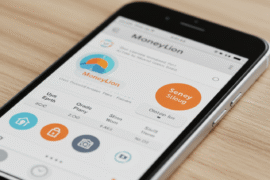This article may contain references to products or services from one or more of our advertisers or partners. We may receive compensation when you click on links to those products or services. Nonetheless, our opinions are our own.
The information presented in this article is accurate to the best of our knowledge at the time of publication. However, information is subject to change, and no guarantees are made about the continued accuracy or completeness of this content after its publication date.
Investing in Meta Platforms
Why Investors Are Watching Meta Platforms
Meta Platforms is a major player in technology and social media, with several widely used apps. Some investors view the stock through a long-term lens, focusing on user engagement trends and product updates that can affect revenue and costs. The company also invests in augmented and virtual reality, as well as AI-enabled devices like smart glasses, which could expand future product lines. These initiatives are meaningful but come with sizable research and operating expenses that influence results. For beginners, the vital thing is to note both the potential and the cost of pursuing it.
- Opportunity: Exposure to a large global user base and advertising platform.
- Innovation involves investing in AR/VR and AI technologies that have the potential to create new categories.
- Headwinds: Regulatory scrutiny, privacy shifts, and changing user behavior.
- Costs: Reality Labs has posted ongoing operating losses that affect profits.
Shorting Otm Puts
Put options are contracts that give the buyer the right to sell shares at a set strike price before expiration. When you sell (short) a put, you take the other side of that contract and receive a premium up front. If the option expires worthless, you keep the premium as income. If the option is exercised or assigned, you must buy the shares at the strike price. It is necessary to understand that selling options exchanges potential income for the obligation to buy stock if the market falls.
Why Use Out-Of-The-Money Puts
An out-of-the-money (OTM) put option has a strike price that is lower than the current stock price. If Meta is trading at $150 and you sell a put option with a strike price of $140, then as long as the shares remain above $140 until expiration, the option will usually expire worthless, allowing you to keep the premium. Traders choose OTM strikes to increase the chance of the option expiring without assignment, though premiums are smaller than at-the-money strikes. If assigned, the trade can be used to potentially acquire shares at an effective price below the market. However, price drops can quickly turn this into a losing stock purchase.
Income Targets and Realistic Expectations
Monthly option income varies with volatility, time to expiration, and strike selection. Some traders aim for modest, low single-digit percentage premiums, but actual results can fluctuate and are never guaranteed. Premiums tend to rise when market volatility is higher, yet risk also increases. New investors should avoid setting fixed “yield” targets and instead evaluate each trade’s risk-reward. A written plan that defines strike distance, time frame, and maximum loss helps keep decisions consistent.
Voted "Best Overall Budgeting App" by Forbes and WSJ
Monarch Money helps you budget, track spending, set goals, and plan your financial future—all in one app.
Get 50% OFF your first year with code MONARCHVIP
Risks and Rewards
While collecting option premiums is appealing, the associated risk is significant: a put seller may be obligated to purchase shares at the strike price, even if the stock’s value has dropped well below that level. Assignment can lead to immediate unrealized losses and additional capital needs. Liquidity, gap moves on news, and broader market sell-offs can also impact outcomes. Please consider position sizing and cash reserves to manage assignments smoothly. Defined-risk alternatives, such as put spreads, can help limit potential losses, but they come with the trade-off of a lower premium.
| Scenario | Outcome |
|---|---|
| Meta stays above $140 | You keep the premium, but the option expires worthless. |
| Meta falls below $140 | You may be assigned, and you must buy shares at $140. |
This simple matrix shows why strike selection matters: the farther below the current price, the lower the premium but the higher the probability of expiring without assignment. Always weigh premium size against the realistic chance and impact of being assigned.
Timing Your Investment
Markets move with earnings, product news, and regulation, so timing affects both premiums and risk. Earnings cycles often elevate implied volatility, increasing premiums but also assignment risk. Broader market trends can dominate single-stock moves, especially during macroeconomic surprises. A calendar of earnings dates, product events, and regulatory milestones can support your planning. Many beginners prefer avoiding new short-put positions right before major announcements until they gain experience.
Monitoring Your Investments
Stay informed with a routine: track company updates, review option Greeks, and watch major index moves. Use alerts for price levels near your strike and for earnings dates. Reassess positions if volatility spikes or if fundamentals change. If assigned, decide whether to hold, write covered calls, or exit based on your plan. Consistency and documentation help you learn faster from each trade.
Minimizing Risk
Diversification reduces the impact of a single position going wrong. Spread exposure across sectors such as technology, healthcare, and consumer goods to balance outcomes. Position the size of each short put so that an unexpected assignment remains manageable. Cash or short-duration Treasuries can provide ballast and fund assignments. A diversified, risk-aware approach supports steadier long-term results.
Getting Started
Begin cautiously with small trade sizes and clear rules on strike distance and expirations. Paper trade or use a tiny allocation to learn mechanics before scaling. As you build experience, consider engaging in defined-risk trades, such as put spreads. Seek guidance from reputable educational resources and, if needed, a licensed financial professional. Keep records of your entries, adjustments, and exits to refine your strategy.
FAQs
Why might Meta Platform’s stock be trading at a discount?
Perceived cheapness can stem from broader tech volatility, shifting growth expectations, or a focus on long-term investments that weigh on near-term profits. Always review current financials, initiatives, and risks before deciding.
What strategy is recommended for this situation?
Some investors sell out-of-money puts to collect premiums and potentially acquire shares at a lower effective price, but the obligation risk must be understood and managed.
What kind of yield can investors expect from this strategy?
There is no guaranteed yield. Premiums change with volatility, time, and strike selection; beginners should avoid fixed targets and focus on consistent risk control.
What risks should investors know when selling OTM puts?
The primary risk is assignment, which obligates you to buy shares at the strike price even if the market is much lower. Large moves, news gaps, and liquidity shifts can increase losses.
How does this strategy align with a long-term investment approach?
Short OTM puts can complement a long-term plan by generating premium and creating disciplined purchase levels, provided you size positions so assignments fit your portfolio.
Final Thoughts
For new investors, Meta Platforms offers both potential and uncertainty, so a steady plan matters. Short OTM puts can generate premium and establish predefined entry points, but they also introduce assignment risk. Keep expectations flexible, document rules, and size positions so a single trade cannot derail your goals. Diversification and cash buffers help absorb volatility and support patient decision-making. With thoughtful preparation and a risk-first mindset, you can build a durable, search-friendly investing guide that genuinely helps readers make informed choices.

Reviewed and edited by Albert Fang.
See a typo or want to suggest an edit/revision to the content? Use the contact us form to provide feedback.
At FangWallet, we value editorial integrity and open collaboration in curating quality content for readers to enjoy. Much appreciated for the assist.
Did you like our article and find it insightful? We encourage sharing the article link with family and friends to benefit as well - better yet, sharing on social media. Thank you for the support! 🍉
Article Title: Investing in Meta Platforms for Beginners
https://fangwallet.com/2025/08/19/investing-in-meta-platforms-for-beginners/The FangWallet Promise
FangWallet is an editorially independent resource - founded on breaking down challenging financial concepts for anyone to understand since 2014. While we adhere to editorial integrity, note that this post may contain references to products from our partners.
The FangWallet promise is always to have your best interest in mind and be transparent and honest about the financial picture.
Become an Insider

Subscribe to get a free daily budget planner printable to help get your money on track!
Make passive money the right way. No spam.
Editorial Disclaimer: The editorial content on this page is not provided by any of the companies mentioned. The opinions expressed here are the author's alone.
The content of this website is for informational purposes only and does not represent investment advice, or an offer or solicitation to buy or sell any security, investment, or product. Investors are encouraged to do their own due diligence, and, if necessary, consult professional advising before making any investment decisions. Investing involves a high degree of risk, and financial losses may occur including the potential loss of principal.
Source Citation References:
+ Inspo
There are no additional citations or references to note for this article at this time.












































